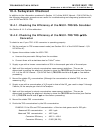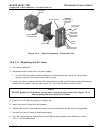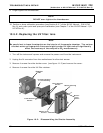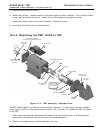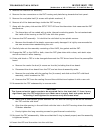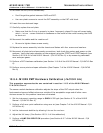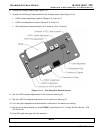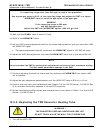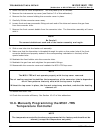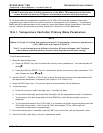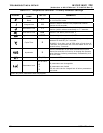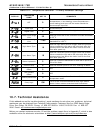
M102E/M501 TRS TROUBLESHOOTING & REPAIR
(Addendum to M101E Manual - P/N 04740 Rev A)
15. Re-insert the PMT/HVPS subassembly.
• Don’t forget the gasket between HVPS and PMT.
• Use new plastic screws to mount the PMT assembly on the PMT cold block.
16. Insert the new desiccant bags.
17. Carefully replace the end plate.
• Make sure that the O-ring is properly in place. Improperly placed O-rings will cause leaks,
which – in turn – cause moisture to condense on the inside of the cooler causing the HVPS
to short out.
18. Reconnect the cables and the reaction cell
• Be sure to tighten these screws evenly,
19. Replace the sensor assembly into the chassis and fasten with four screws and washers.
20. Reconnect all electrical and pneumatic connections, leak check the system and power up the
analyzer. Verify the basic operation of the analyzer using the ETEST and OTEST features (see
Section 6.9.5 & 6.9.6 of the M101E Manual - P/N 04740 Rev A) or by measuring calibrated
zero and span gases.
21. Perform a PMT Hardware calibration (see Section 11.6.6 of the M101E Manual - P/N 04740 Rev
A)
22. Perform a zero point and span calibration (See Chapter 7 of the M101E Manual - P/N 04740
Rev A)
10.5.4. M102E PMT Hardware Calibration (FACTORY CAL)
This procedure supercedes the one contained in section 11.6.3 of the M101E Manual -
P/N 04740 Rev A.
The sensor module hardware calibration adjusts the slope of the PMT output when the
Instruments slope and offset values are outside of the acceptable range and all other more
obvious causes for this problem have been eliminated.
1. Set the instrument reporting range to SNGL & 500 ppb (see Section 6.7.4 of the M101E
Manual - P/N 04740 Rev A)
2. Perform a full zero–point calibration using zero air (see Chapter 7 of the M101E Manual - P/N
04740 Rev A).
3. Let the instrument stabilize by allowing it to run for one hour.
4. Adjust the UV Lamp. (See Section 10.5.1.1 of this addendum)
5. Perform a LAMP CALIBRATION procedure (see Section 6.9.7 of the M101E Manual - P/N
04740 Rev A).
05514 Rev A1 61




